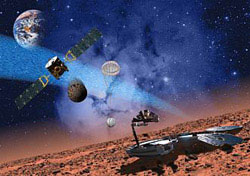[Previous entry: "Conversation with a banker"] [Next entry: "Even in self-interest, help!"]
28/05/2004: "Beagle's second death"
 The results of the independent and transparent investigation called after the loss of Beagle 2 are disappointing, "a bungled report into the failure of a Mars lander", as reported in the Economist. First of all, the investigation was all but independent, with most members of the group being or having been on the ESA's payroll. And the report is to remain secret, even from the scientists who designed and built the lander.
The results of the independent and transparent investigation called after the loss of Beagle 2 are disappointing, "a bungled report into the failure of a Mars lander", as reported in the Economist. First of all, the investigation was all but independent, with most members of the group being or having been on the ESA's payroll. And the report is to remain secret, even from the scientists who designed and built the lander.
Comments made by the ESA on this issue: “we live in an open society too, but it's open in a different way”. And, having the inspector general of ESA chair the inquiry did “a little bit of harm to the word independent”.
Unsurprisingly, then, the main thrust of the report is that if ESA had been in charge, everything would have been better. It also suggests that money for future high-risk space projects should all come from governments, rather than the messy corporate world. The reasoning behind such advice remains a mystery. Such a recommendation neatly ignores the fact that if the agency had its own way from the start, Beagle 2 would have never been built in the first place. Beagle’s innovative approach to raising finance—using popstars and artists to generate interest in the project—did not meet with approval from the European agency.
As to why Beagle crashed, Colin Pillinger, who was the moving spirit behind Beagle 2, believes the most likely explanation for the craft’s failure is that the Martian atmosphere at that time of year was much thinner than anyone, including NASA, had predicted.
At a press conference on May 24th to announce the findings of the secret inquiry, there were hints of a return to Mars under ESA’s Aurora programme. The questions that Beagle 2 sought to answer, such as whether life exists, or existed, on Mars, still need to be addressed.
Source: The Beagle 2 mission (in The Economist)


